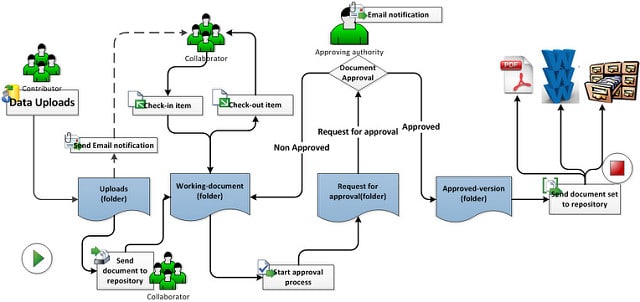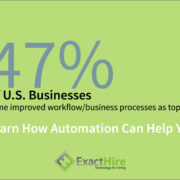Onboarding New Employees At Multiple Locations
“You just need a little time to get your feet wet.” Onboarding new employees could be described as the process whereby a new employee gets her proverbial feet wet. It’s a process of discovering something for the first time, overcoming fear and anxiety, and gradually becoming familiar, comfortable with a new experience. It’s a slow, measured lowering into the water–starting with the feet. A summer dip in the pool.
Sadly, far too many new employees never experience that placid scene. Their experience is quite the opposite. It’s more akin to Uncle Larry running across the the pool deck in all his gut jostling glory, scooping up nieces, nephews, unaware bystanders– and an unfortunately placed inflatable–before lunging mercilessly into the deep end with all wrapped in his arms. “Uncle Larry I can’t swim!”
Of course, the “sink or swim” approach works at some places. When it’s planned. And when it involves experienced swimmers. And when Uncle Larry isn’t in charge. But regardless of whether your employee onboarding process is measured and methodical or fast and furious, it becomes exceedingly difficult to manage outcomes when onboarding employees at multiple locations.
No Guard On Duty
Onboarding new employees at multiple locations is a challenge because it’s rarely possible to have a person dedicated to guarding the process at each location. Things get dropped, forms don’t get signed (or counter-signed), documents are lost, important instructions are delivered secondhand or not at all…the list goes on. So for organizations who must onboard employees across multiple locations, many must default to the “sink or swim” approach because they simply do not have the HR staff to facilitate anything else.
However, when no one is around to determine whether a new employee is sinking or swimming in the early stages of employment, a number of negative outcomes can result. These include:
Inconsistent Service or Operations
New employees–to a business’s customers–are just employees. Customers don’t care if they are receiving subpar customer service from a new employee–it’s still subpar service, and it’s not appreciated. When new employees are thrown into a position without adequate preparation, operations and customer service will suffer.
Low Employee Morale
Perhaps a new employee is doing well, but no one is affirming her work in the early weeks. She thinks she’s doing well, but she’s not too sure and so anxious. Over time, that anxiety turns into ambivalence. Ambivalence will soon become resentment. Resentful employees don’t stick around; they start looking for new opportunities.
Low Productivity
Maximizing productivity depends on consistently executing optimized processes efficiently. New employees who are poorly onboarded may lack the knowledge or motivation (sometimes both) to execute a process efficiently, even if that process is optimal. In other words, bad employee onboarding may lead to bad business outcomes.
Rapid Employee Turnover
The initial results of bad employee onboarding are experienced by the employee and felt by the customer; however, eventually this all comes back to injure the employer–specifically, the employer’s brand. A negative employer brand makes it increasingly difficult to grow a business and hire new employees. And maintaining a constant hiring cycle with minimal growth is expensive and ultimately unsustainable for many small- to medium-sized businesses. Hand-in-hand with low employee morale, rapid employee turnover can have a lasting effect on an organization.
Planning Your Pool Party
For organizations with multiple “pools” of employees spread across a geographic area, hiring an HR representative for each location is not likely feasible. So those organizations must find a way to ensure that they are consistently and effectively onboarding new employees at multiple locations. Here are a couple options:
Train Location Managers In Onboarding
Additional onboarding-related training for location managers could equip them with the skills to successfully handle new employee onboarding themselves. In a perfect world, managers would welcome and execute this with open arms, but in the real world it would be scoffed and scorned into oblivion (ain’t nobody got time for that).
Onboard In One Location
A more sophisticated, complex approach to onboarding could involve moving the process to one location. This would see new employees spending their first week at one location, learning the ropes, and then “graduating” to new locations after the onboarding period had ended. With perfect execution this could work too, but who’s to say that a new employee’s experience at the second location wouldn’t differ from her first?
Although the above approaches may work under certain circumstances, the introduction of onboarding software easily tops both.
Cannonball!
To really make a splash during the new employee onboarding process, employers should seek to eliminate monotony and simplify complexity. Employee onboarding software can do this, and for organizations with employees at multiple locations, it has the added benefit of reducing the need for HR staff at every location. How?
By providing tools to digitally manage tasks, documents, and forms, employee onboarding software makes possible the following:
Enter Once, Populate Many
Once an employee enters information into a field, that information automatically populates other fields and documents that require it. No more entering your name and address multiple times.
Electronic Signatures
Collecting, counter-signing, and filing documents can be eliminated completely. Electronic signatures allow for documents and forms to be processed and stored digitally, saving time and resources–and avoiding the headaches of paper chasing.
Task Assignment and Completion Triggers
Schedule required onboarding tasks to be assigned contingent upon the completion of other tasks. This allows an organization to control the timing and pace of the process, which helps ensure that new hires feel comfortable and not overwhelmed.
E-Verify Integration
Onboarding software that features an E-Verify integration drastically reduces the time needed to verify the employment eligibility of new hires. Using information the employee submits electronically via the required Form I-9, software with this integration submits the information to E-Verify, where the information is checked against a federal database and a status returned almost immediately.
Bring The Employee Onboarding Process Alive!
Employee onboarding software succeeds in bringing consistency and quality to the new employee onboarding process by centralizing control of the process in the hands of the Human Resources Department. By automating many of the monotonous and complex tasks required of both new employees and HR, the software provides human resources professionals with the space and time to bring the employee onboarding process alive.
So the next time your organization is analyzing employee turnover metrics or brainstorming ideas for employee engagement and retention, take the time review your employee onboarding process. Are you inviting new hires to enjoy the cool, calm waters of your organization at reasonable, comfortable pace? Or are you bum rushing them into Uncle Larry’s wild pool party?
ExactHire offers hiring and employee onboarding software to growing small- to medium-sized businesses that are looking to efficiently attract, hire, and retain exceptional talent for continued growth. To learn more about ExactHire’s HR solutions, please submit a brief contact form.
Image credit: Document-management-workflow (Click on image/Press L for a full view) by Saad Faruque (contact)
No Lifeguard On Duty by Myrtle Beach TheDigitel (contact)
Belly Flop Contest by Steven Depolo (contact)
Pool Rules Girls Pool Party Lourdie by prayitnophotography (contact)











 15% OFF FULL-SERVICE HIRING • APPLICANT TRACKING SOFTWARE • ONBOARDING SOFTWARE
15% OFF FULL-SERVICE HIRING • APPLICANT TRACKING SOFTWARE • ONBOARDING SOFTWARE